January 11, 2008
Air Date: January 11, 2008
FULL SHOW
SEGMENTS
Growling Over Polar Bears
View the page for this story
The U.S. Fish and Wildlife Service has failed to meet a federal deadline to determine whether to protect the polar bear under the Endangered Species Act. Some environmental groups say the Bush administration is ignoring the effects of global warming on the animals. Host Steve Curwood talks with Bill Snape, Senior Counsel for the Center for Biological Diversity, about the delay. (05:45)
Liability Crosses Borders
/ Ingrid LobetView the page for this story
A lawsuit brought by Indian tribes in Washington State has made new law. The law says companies outside the U.S. may be held responsible for pollution they cause in the U.S. The decision troubles some corporations but the tribes wonder when it will lead to cleanup of a century’s worth of waste from the world’s largest lead and zinc smelter in Canada. Living on Earth’s Ingrid Lobet reports. (06:00)
Revealing Romney
/ Bruce GellermanView the page for this story
Living on Earth’s Bruce Gellerman tails Mitt Romney on the campaign trail in New Hampshire. He also looks at Romney’s environmental record as governor of Massachusetts and his surprising last minute rejection of the Regional Greenhouse Gas Initiative, a market-driven system to control greenhouse gasses in the Northeast. (08:50)
Power Struggle
/ Jeff YoungView the page for this story
A Department of Energy plan to push for more electric power lines is sparking protest. Opponents say the lines would cut through important natural and historic areas. Living on Earth’s Jeff Young visits a Civil War battlefield to see what might be at stake. (05:30)
The World’s Cheapest Car
View the page for this story
Car ownership for India’s growing middle class may becoming a bit more accessible. The Tata Motor Company announced they will manufacture the Nano Car with a pricetag of just $2,500. Host Steve Curwood talks with Sunita Narain, director of the Center for Science and the Environment in Delhi, about what the Nano Car could mean for the developing world and how India should handle its transportation issues. (03:30)
The Future of Artificial Intelligence
View the page for this story
In the first of a two-part conversation, host Steve Curwood sits down with famed inventor and futurist Ray Kurzweil to look at some of his inventions and discuss the future of artificial intelligence. Kurzweil says that "the singularity" is near - a time when we will merge with our technologies, and greatly expand our human potential. (08:45)
Lieutenant Fluffy?
View the page for this story
Some feral cats in California have been given jobs with the Los Angeles Police Department... as mousers. Host Steve Curwood talks with Commander Kirk Albanese who helped organize the feral cat program with the LAPD. (03:55)
Born to Be Wild
View the page for this story
In the aftermath of the Siberian tiger attacks at the San Francisco Zoo, commentator Sy Montgomery ponders a number of questions, including whether predatory animals are meant to be kept in captivity. (03:15)
This week's EarthEar selection
listen /
download
Show Credits and Funders
Show Transcript
HOST: Steve Curwood
GUESTS: Kirk Albanese, Valerie Fellows, Ray Kurzweil, Sunita Narain, Bill Snape
REPORTERS: Bruce Gellerman, Ingrid Lobet, Jeff Young
COMMENTATORS: Sy Montgomery
[THEME]
From Public Radio International—this is Living on Earth.
[THEME]
CURWOOD: I’m Steve Curwood. Water, water, everywhere—drowning the habitat of the polar bear—and giving the great white beast a new role.
SNAPE: The polar bear is becoming the symbol for what is wrong with global warming, and the arctic ecosystem,- of which the polar bear is a part,- is suffering the impacts of global warming first. But I hope it becomes the symbol of what can be done.
CURWOOD: Also, Republican Presidential candidate Mitt Romney says what should be done is win energy independence for America—and that might mean drilling in the far north.
ROMNEY: We use too much foreign oil—we send about a billion dollars a day out of our country to buy oil from other people. That billion a day could be invested here.
CURWOOD: Presidential hopeful Mitt Romney—and thoughts on wild cats—and more this week on Living on Earth. Stick around!
ANNOUNCER: Support for Living on Earth comes from the National Science Foundation and Stonyfield Farm.
Growling Over Polar Bears

Polar bear and cubs (Photo: Steve Amstrup/U.S. Fish and Wildlife Service)
CURWOOD: From the Jennifer and Ted Stanley Studios in Somerville, Massachusetts—this is Living on Earth. I’m Steve Curwood. As the habitat of the polar bear disappears with arctic sea-ice, this great beast has become an icon of the consequences of global warming.
And though the polar bear may be in danger, the U.S. Fish and Wildlife Service recently missed a deadline to decide whether the polar bear needs the protection of the Endangered Species Act. The agency says it needs another month to consider research from the U.S. Geological Survey on polar bears and sea ice, as well as a flood of public comments in support of the listing.
That delay has prompted environmental groups to start legal action to force the government to make a decision. Joining me now is Bill Snape, he’s chief counsel with the Center for Biological Diversity—welcome to Living on Earth.
SNAPE: Hello!
CURWOOD: So, as I understand it, your organization has filed a notice of intent to sue.

Bill Snape, Senior Council at the Center for Biological Diversity (Courtesy of Bill Snape)
CURWOOD: ‘Bogus?’ That’s a strong word.
SNAPE: Well, this is an agency that has had well over a year to take a look at their own listing proposal. The original petition to list the polar bear was submitted in 2005. And the report upon which they are relying now in claiming that it was late was submitted in September. So, we think waiting even a month for this species is too long, as its habitat does continue to melt.
And I think, perhaps most importantly, you must look at this delay in the overall context of Bush Interior Department’s Endangered Species Act record. This is an agency that has not listed any species in over one year and one half. So the polar bear delay must be viewed in that context and it frankly makes us very suspicious.
CURWOOD: Now the Minerals Management Service of the Interior Department has announced that it will hold a sale on oil and gas leases in the Chuckchi Sea, and that’s an area within polar bear habitat within in the next few weeks. And that’s before the Fish and Wildlife Service will make a decision on listing the polar bear. To what extent did that affect your decision to file this notice of intent to sue now?

Polar bear and cubs (Photo: Steve Amstrup/U.S. Fish and Wildlife Service)
So, the fact that on the one hand you’ve got a polar bear decision that is late under the Endangered Species Act, and on the other hand they manage to get the lease sale done quite on time—in fact, early—when you add that up it’s the same old Bush Administration, the same old anti-environmental policies. And that spells bad news for the polar bear.
CURWOOD: Now, we spoke with Valerie Fellows. She’s a spokesperson for the Fish and Wildlife Service and she told us that the polar bears will have plenty of protections, even if the leases are used for oil and gas drilling. Let’s hear her now:
FELLOWS: With or without an endangered species listing, MMS will still have to comply with a NEPA analysis—a National Environmental Policy Act analysis. And comply with the Marine Mammal Protection Act, which already protects polar bears.
CURWOOD: So she’s saying that the Department of Interior must comply with the Marine Mammals Act, which already protects polar bears—ESA listing or not. What’s your response?
SNAPE: Well, as a lawyer my response is twofold: Under the National Environmental Policy Act, one of the two statutes that she mentioned, you must remember that that is a procedural statute. As long as the agency analysis is honest and forthright, you can say ‘we’re going to destroy the habitat,’ put it in an environmental impact statement, and that’s the end of the ball game under NEPA. So, NEPA’s not the answer to protect the polar bear here.
The Marine Mammal Protection Act does offer some modicum of protection for the polar bear, but it pales in comparison to what the Endangered Species Act does. So really that is a weak answer at its very best.
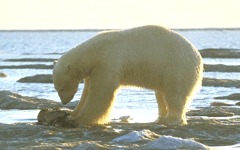
A hungry polar bear. (Courtesy of DOI)
SNAPE: Well the Endangered Species Act is a tool in the kit to protect the polar bear and to deal with global warming. It is absolutely not the only tool. I don’t see Governor Palin out in front leading the charge for Congress to pass emissions controls, which obviously would help global warming. And so to the extent that imperiled species are declining because of global warming—the Endangered Species Act is a solution.
My prediction is: eventually the Bush Administration or a subsequent administration is going to have to list the polar bear. The science is just overwhelming. And I sort of predict that not all oil and gas leases are going to stop the next day. So again to repeat—the Endangered Species Act is one of many tools to deal with global warming. It is not the only tool. And we would love to see Governor Palin, we’d love to see Secretary Kempthorne, we’d love to see the president of the United States endorsing some legislation to deal with global warming head on. That would be great news.
CURWOOD: If you are successful, would one end up saying that the polar bear would be much like the spotted owl—the little bird that stood up to prevent the clear cutting of the northwest forests?
SNAPE: Yes. The polar bear is becoming a symbol for what is happening as a result of global warming. And the arctic ecosystem of which the polar bear is a part is suffering the impacts of global warming first—quite early. The science is very clear on that. And I have two young boys. I am fearful, based on the science I have read, that polar bears will not be seen in the wild when they are my age. And that is to me a truly frightening thought. So yes—the polar bear is becoming the symbol for what is wrong with global warming but I hope it becomes the symbol of what can be done.
CURWOOD: Bill Snape is senior counsel for the Center for Biological Diversity. Thank you so much, sir.
SNAPE: Thank you.
Related links:
- Statement for Polar Bear Decision, U.S. Fish and Wildlife Service January 7, 2008
- Center for Biological Diversity
Liability Crosses Borders
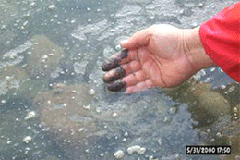
Smelter waste at a public beach in Northport, Washington. (Photo: Patti Bailey)
CURWOOD: We stick with the legal issues for this next story. It's now the law that industries outside the United States, whose emissions flow or drift into the U.S., can be held liable for the damage they cause. The Supreme Court has let stand an appeals court ruling to that effect.
And Indian tribes in Washington State now hope that brings them one step closer to a massive cleanup of the Columbia River near the Canadian border. Living On Earth's Ingrid Lobet reports.
[MUSIC: Alan Jackson “USA Today” from What I Do (BMG Music 2004)]
LOBET: Where the Columbia River enters the United States, radio stations play country and western, and the ads are for outdoor gear and ammunition. Big belly mountains rise and then ebb into valleys.
[SOUND OF WATER]
LOBET: The biggest valley of all belongs to the Columbia River. And on the reservation side of the river, a Colville tribe environmental official named Patti Bailey, picks red willow shoots from the blackish river bank.
BAILEY: This is a tribal campground on the Colville reservation. It's an area used for thousands of years by tribal members as a hunting and fishing area. Now I come here to collect red willow.
LOBET: She holds the willow stem in her teeth and strips the core with a knife.
BAILEY: I'm a basket weaver. In my adult life I learned how to weave baskets. We're trying to keep that tradition alive. It's not uncommon for people to put materials in their mouth and hold it there while they're weaving.

Smelter waste at a public beach in Northport, Washington. (Photo: Patti Bailey)
Most of the discharges stopped more than a decade ago, but the Colville and Spokane tribes here have been trying for years to find out the ecological and human health risks of the material. Don Hurst is a geologist and toxic cleanup manager with the tribes.
HURST: What we're looking at here is about 73 percent slag that is sourced from the Teck Cominco smelter.
[SOUND OF GLASSY SLAG]
HURST: Contaminants of concern are like lead, arsenic, zinc, copper. The concentrations of arsenic and lead are at about the same levels that have driven emergency cleanups in other locations.
BAILEY: You know, there's all kinds of animals that use this area. There’s raccoons, and river otters, deer, bear. And lots of animals that the tribes do consume.
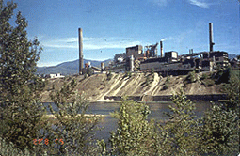
The Trail Teck Cominco facility, British Columbia, Canada. (Courtesy of Colville Confederated Tribes)
Now their worries have been confirmed. The Supreme Court has let stand a 9th Circuit ruling that the metals giant Teck Cominco can be sued in U.S. courts using Superfund law.
Dave Godlewski, vice president of environmental and public affairs for Teck Cominco American, says that's a big deal.
GODLEWSKI: I think the implications are really far reaching. They extend to border countries, certainly Mexico and Canada, but I guess could be applied universally. One of our attorneys brought up the potential for island countries in Polynesia to sue the U.S. because of greenhouse gas emissions. It really opens an interesting door to the prosecution of cases that involve transnational transmission of pollutants.
LOBET: Godlewski says it's most important to realize that just because the company fought U.S. jurisdiction, doesn't mean it won't clean up its legacy along the Columbia River.
GODLEWSKI: That's a message that's often lost in all the rhetoric around this, that we have made a commitment to do what is the right thing here, to take our responsibilities very seriously. And I think that is the message I would like to leave with your listeners. That this isn't the case of a recalcitrant polluter. This is someone who is taking responsibility for its actions but felt it was necessary to defend itself with regard to these larger jurisdictional issues.

This is a popular "black sand" beach near the Canadian border that many people use for fishing and swimming. The black sand is slag from the Teck Cominco smelter facility. (Photo: Patti Bailey)
LOBET: But the long fight has made some tribal leaders wary. Again Patti Bailey:
BAILEY: They’ve sat on our watershed boards. They’ve sat across the table from us and talked to us about them cleaning up their industry in Canada, and that’s been wonderful. But they've had decades to do the right thing down here and they haven't done it. And they won't do it until they’re made to.
LOBET: First the facts and history of Teck Cominco's legacy will probably have to be argued in federal court in Washington state. But in the meantime, there is progress in answering the tribes' health and wildlife concerns. The metals company is working with EPA on the large job of gathering data and gauging risk.
Some earlier tests indicate possible problems for wildlife. Marc Stifelman, an EPA toxicologist, says one example is the bottom-dwelling fish known as ‘suckers.’
STIFLEMAN: One of the things we found is the suckers we sampled in the upper reaches of the river: their guts were literally filled with slag. And we're actually having to adjust our analytical procedures for the fish. It was to such a degree that we’re actually having to dissect the entire gastrointestinal tract out of these suckers and separate it from the rest of the fish tissue, because it has such a large mass of slag.
LOBET: Neither the health or liability questions on the upper Columbia are settled, but the case has now made law that could be felt elsewhere, where pollution, heedless, crosses borders. For Living On Earth, I'm Ingrid Lobet.
Related links:
- Colville Confederated Tribes
- LOE: U.S. Indian Tribes Challenge Canadian Company’s Legacy of Waste
- Teck Cominco
[MUSIC: Karl Denson: “Rumpwinder” from Dance Lesson #2 (Blue Note Records 2001)]
Revealing Romney
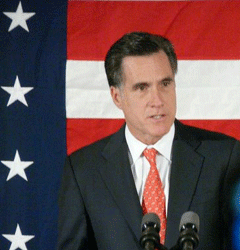
(Photo: Bruce Gellerman)
CURWOOD: Just ahead—presidential hopeful Mitt Romney and the environment. Stay tuned to Living on Earth.
CURWOOD: It’s Living on Earth. I’m Steve Curwood. Throughout the presidential campaign Living on Earth has been examining the energy and global warming policies of the candidates. Today we turn to Republican and former Massachusetts Governor Mitt Romney.
Living On Earth’s Bruce Gellerman went on the campaign trail with Governor Romney during the recent New Hampshire primary, and has this report.
GELLERMAN: By his own count Mitt Romney made hundreds of campaign appearances in New Hampshire.
[SOUND OF LOTS OF PEOPLE TALKING IN GATHERING]
Most were of the meet-and-greet variety like this one at Norton’s Classic Restaurant in Nashua, where you can sit in a blue and pink booth fashioned out of a 1950’s T-bird. With reporters and photographers in tow, Romney makes the rounds.
ROMNEY: Well there are a couple of things. One is—my view—is that families ought to be able to save their money tax-free.
GELLERMAN: At this stop just two people were interested in talking about the environment. Eight-year-old Nick Gage and his dad Kevin. Nick just finished a school report on global warming.
NICK GAGE: Well I learned that if we don’t save the polar bears and like, put them in a colder place they’ll probably die off.

Kevin, Nick and Alex Gage at Norton's Classic Restaurant in Nashua, NH (Photo: Bruce Gellerman)
KEVIN GAGE: I think global warming is an important issue. It’s not number one on my list. We actually just bought a car, but we couldn’t afford to get into a hybrid, which was really kind of stinky. With kids we couldn’t do the Prius because it’s you know, you couldn’t do it.
GELLERMAN: Likewise, for Mitt Romney, global warming isn’t so much an environmental issue as an economic and national security issue. Here he’s answering a question at one of his ‘Ask Mitt Anything’ meetings in Hudson, New Hampshire.
ROMNEY: I believe the planet’s getting warmer and I believe that human activity is contributing to the planet getting warmer. I’m not a scientist so I don’t know how much is human and how much is due to other cyclical factors we don’t understand. I just don’t know.
But I do know this; we can reduce the impact of human activity by reducing our emissions of greenhouse gases. And the best way I know to do that is to put us on a track to becoming energy independent of foreign oil. Because getting us to do that would mean less use of oil and more use of liquefied coal, where you sequester the CO2, nuclear, solar, wind power, biodiesel, biofuel, ethanol, cellulosic ethanol, and more efficient vehicles and homes and business. You do those things: our greenhouse gas emissions come down a lot.
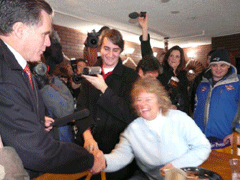
This supporter went for the mitt. (Photo: Bruce Gellerman)
ROMNEY: We use too much foreign oil. We send about a billion dollars a day now out of our country to buy oil from other people. That billion a day could be invested here. But instead it’s going out there—to Ahmadinejad, and Chavez and Putin and others—some of whom use it against us.
GELLERMAN: Romney supports drilling for oil in ANWR, the Alaskan National Wildlife Refuge, and in off-shore coastal waters—but not near Florida. And he opposes the Kyoto Climate Accord because it doesn’t require developing countries to cap their climate changing emissions.
Romney is for improving the efficiency of automobiles but opposes mandates requiring carmakers to increase gas mileage. He wants to recycle nuclear waste but is waiting for the latest scientific studies before taking a position on the controversial Yucca Mountain nuclear waste site in Nevada.
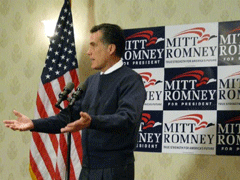
Working the crowd in New Hampshire. (Photo: Bruce Gellerman)
ROMNEY: This is not something that’s going to get solved in ten years. We can't become energy independent in ten years, but we can get ourselves on a track to do that. It's going to require a far more substantial investment by our nation in energy technology. Right now, we spend about $4 billion a year on new sources of energy and energy efficiency. We're going to have to increase that dramatically.
GELLERMAN: On the campaign trail Romney is a consummate politician—hand outstretched, sporting a smile with a quick wit and ready quip. He’s fond of quoting Yogi Berra.
ROMNEY: Did you have a good breakfast? It’s a little crowded in here now. What is it that Yogi Berra said, which is ‘the place is so crowded nobody goes there anymore.’
GELLERMAN: If Yogi Berra were a reporter trying to learn about Romney’s environmental record, he might say ‘you can learn a lot about history by studying the past.’ So, I found people familiar with Mitt Romney’s environmental record when he was governor of Massachusetts. Sonia Hamel worked as a senior official in various state environmental offices for 25 years, under seven governors.
HAMEL: Actually Governor Romney is a wonderful manager. He was a very metrics-oriented manager and I think he was good at that.
GELLERMAN: Romney managed the Governor’s Office like the businessman he was and won praise from environmentalists for filing first-in-the nation legislation to protect coastal waters. He signed a bill phasing out mercury in consumer products, and brokered a deal to clean up the state’s dirtiest power plants. Romney even weather stripped the windows in his home, saving $128 a year on his heating bill.
But he got the highest praise for creating a new cabinet position overseeing energy, transportation, housing and the environment and appointing the president of the Conservation Law Foundation—an ardent environmental advocate—as its head.
The move pleased George Bachrach, president of the Environmental League of Massachusetts and a former Democratic state senator.
BACHRACH: I think many of us in the state were excited by Mitt Romney. We may not have agreed with him on issues. He may not have been our cup of tea in many ways but we were impressed by his degree of intellect, entrepreneurial spirit, reform-minded, fresh set of eyes, and I think many of us were greatly disappointed when he became something else.
GELLERMAN: Critics say the transformation of Mitt Romney took a few years. Romney—who said he supported wind power—joined forces with opponents, including Ted Kennedy, against a wind project off Cape Cod. He cut the state’s environmental budget, and spending on parks and land preservation.

Mitt Romney delivers a speech on the campaign trail in N.H. (Photo: Bruce Gellerman)
HAMEL: In my 25 years of doing program development in state government I never had been involved in a program as well analyzed and as well modeled as RGGI. We spent three years designing it and had a great deal of certainty that price increases would be extremely modest—probably on the order of two or three percent. And that actually if we did good work on energy efficiency we could reduce that to having no price increase.
GELERMAN: Romney had whole-heartedly supported the regional curb on greenhouse gases. In November of 2005 he said—quote: ‘this is a great thing for the Commonwealth. I’m convinced it’s good for business.’
Then, suddenly, just a month later, on the same day he announced he wasn’t seeking re-election, Governor Romney said he was withdrawing from RGGI. Here’s Romney explaining his change of heart on New Hampshire public radio’s program the Exchange:
ROMNEY: I had literally one of our largest employers tell me they would not build another facility in our state if we signed the bill as it was without a cap. So I insisted that the other parties put a cap in. The other states would not and I said, very simple: ‘if the other states aren’t going to allow us to have a cap I can’t sign it.’
GELLERMAN: Again, Sonia Hamel, the Massachusetts official who negotiated the greenhouse agreement:
HAMEL: I was personally really surprised and disappointed because we had done our homework on that program and it was designed very cautiously. So yes, it was a terrible disappointment to me.
GELLERMAN: So, what happened? What changed?
HAMEL: I can’t tell you exactly. I wish I could look into the mind of Governor Romney when he was making these decisions but he faltered. In terms of making the decision he listened a lot to scare tactics. I don’t know.
GELLERMAN: The upcoming Michigan primary could be the make or break vote for Mitt Romney. The role his environmental record and platform will play won’t be known until the votes are analyzed, or as Yogi Berra would say; ‘it ain’t over til it’s over.’ For Living on Earth I’m Bruce Gellerman.
Related link:
Mitt Romney's campaign website
[MUSIC: Sam Mickens/Sam Horist “Things Behind The Sun” from Poor Boy: The Songs Of Nick Drake (Songlines 2004)]
Power Struggle
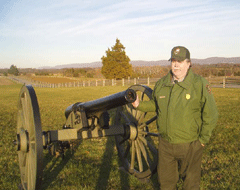
“The impact is going to be pretty devastating.” Antietam National Battlefield Park Superintendent John Howard says millions in taxpayer dollars went to preserve the view here. (Photo: Jeff Young)
CURWOOD: The U.S. Department of Energy is mapping out potential paths to bring power to the people. Officials say these ‘national interest electricity corridors’ will speed construction of power lines needed to meet the increasing demands of energy-hungry Americans and avoid the threat of blackouts.
But some landowners and conservationists don’t like the prospect of massive pylons and cables lumbering across the landscape. They say the power line plan would mar scenic vistas and put the country on a path to more global warming. Living on Earth’s Jeff Young reports.
YOUNG: John Howard looks out on the fields and forests where he works, a place that once saw the single bloodiest day of combat in U.S. history.
HOWARD: The leaves are off the trees, you know, we’re looking out over split rail fences and stone walls towards Antietam Creek over some of the most historic and hallowed ground in the United States.
YOUNG: Twenty-three thousand were killed or wounded here at Antietam, in Maryland. As superintendent of the national park, it’s Howard’s job to keep the Civil War battlefield and its surroundings intact. He’s had help from the state, which spent millions to protect the sweeping view of old farmlands and the forested ridge of nearby South Mountain. Howard says the vista helps visitors connect to their history.

“The impact is going to be pretty devastating.” Antietam National Battlefield Park Superintendent John Howard says millions in taxpayer dollars went to preserve the view here. (Photo: Jeff Young)
YOUNG: Those 19th century soldiers did not look up at high voltage power lines, but Howard fears his visitors might. The Allegheny Power Company wants to get more of its electricity to the Washington and Baltimore areas with a power line through Maryland, and preliminary route maps place it close to Antietam. Howard says that could mean a treeless swath of giant metal towers dominating the view of South Mountain, near where Union and Confederate troops clashed in early skirmishes.
HOWARD: Well I think the impact is going to be pretty devastating. That dirt there is the dirt that these soldiers fought on, bled on, and died on. The idea that it’s not a little bit more important than a power line, I think if we get to that point we’ve lost a lot.
YOUNG: It’s just one of a half dozen power line battles brewing in the Mid-Atlantic and Northeast. Electric utilities want to link their big power plants in the Ohio River Valley to eastern seaboard cities. And natural, historic and scenic areas are often in the path.
State regulators usually handle disputes like this. But this time the federal government might step in. In its 2005 Energy Act, Congress told the Department of Energy to find areas of electricity congestion—that’s where transmission lines can’t deliver all the generated power to consumers. The Energy Department’s Kevin Kolevar says those areas are now national interest electricity transmission corridors.
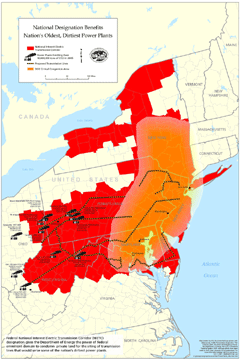
The red area shows the National Interest Electric Transmission Corridor. The orange area shows the DOE critical congestion area. The black and yellow dotted lines are proposed transmission lines. Finally, the smokestacks mark coal-fired power plants emitting over 10,000,000 tons of CO2 in 2005. (Courtesy of Piedmont Environmental Council)
YOUNG: If states in those corridors fail to approve a power line, the federal government could push for it—even using eminent domain to take property if needed. That has sparked angry protest from governors and attorneys general who say state rights are being trampled. Pennsylvania Democratic Senator Bob Casey complains the Energy Department gave Pennsylvania residents little notice that the designation was coming.
CASEY: I mean, to designate a corridor through 52 counties and have one meeting is beyond obnoxious.
YOUNG: The Energy Department’s mid-Atlantic corridor designation covers seven states from upstate New York through Virginia. Another corridor for the Southwest includes California and Arizona. Now a coalition of two dozen environmental groups is suing the energy department to stop those designations.
Cale Jaffe with the Southern Environmental Law Center says what worries him is not just what’s in the path of the power corridors but what’s at the ends of them. The lines would link to coal-rich regions where it’s easier to get permits for a power plant.
JAFFE: The utility companies are seeking to build power plants where they think environmental rules are most weak. It’s literally an example of running away from our nation’s most progressive environmental protections.
YOUNG: Jaffe says the power lines would encourage new coal power plants and that would mean decades of more heat-trapping greenhouse gas emissions. The legal challenge from his group and others says the government failed to consider other ways to meet power demand, like energy efficiency programs. Some studies show efficiency could reduce projected electricity demand in the mid-Atlantic by as much as a third.
But the energy department’s Kevin Kolevar says while the department supports efficiency, new power lines would still be needed to avoid the threat of blackouts.
KOLEVAR: Efficiency is not in the calculation, nor should it be in this calculation. This is what it is. This focuses on the ability to have the federal government look at new transmission if there is a national interest.
YOUNG: Now it’s up to the federal courts to untangle this power struggle over power lines. For Living on Earth, I’m Jeff Young in Antietam, Maryland.
Related links:
- The US Dept. of Energy has maps and background information on the national interest corridors
- Piedmont Environmental Council says the power lines would lead to more pollution
[MUSIC: Aiko Shamada/Sam Horist/Tucker Martine “Cello Song” from Poor Boy: The Songs Of Nick Drake (Songlines 2004)]
The World’s Cheapest Car
CURWOOD: Tata Motors, a car company in India, has just unveiled its newest auto. It’s a four-door hatchback that will sell for about $2,500 dollars. That means that millions of consumers in developing countries who currently rely on motorbikes, or buses, or their feet, will be able to achieve that dream of middle-class life and buy a car.
Some commentators are welcoming this new people’s car as a sign of India’s progress, and a safer alternative than overcrowded buses or overloaded motorbikes. Others see a cause for worry—more smog at home and more greenhouse emissions.
Sunita Narain, Director of the Center for Science and the Environment spoke on the phone now from her office in Delhi, India. She says India needs to radically improve its public transportation rather than boost the number of cars clogging the roads.
NARAIN: The numbers of people who travel on the bus are much larger than the numbers of people who travel by motorbike or by car. Cars actually in my city, travels only 20 percent of the people or less, but it occupies 90 percent of the road space. And that’s what we want to reverse. That’s what we want to change.
CURWOOD: How do you get to work and do your own shopping?
NARAIN: I go to work in a car because the buses are lousy in India—in Delhi. But I would love to travel by bus or bicycle.
CURWOOD: It’s too dangerous by bicycle, though.
NARAIN: Delhi’s actually now beginning to invest in bicycle lanes and we are beginning to have our first high-capacity bus corridor. So it’s a question of really how Indians will reinvent mobility and whether we, in India, have the confidence to be able to do what the rest of the world has not done.
CURWOOD: So that is the question, then. To what extent is India prepared to leapfrog the rest of the world to not have snarled expressways and highways and traffic mostly at a standstill. I mean, here in the Boston area I think they say that 100 years ago the average speed through town was a little bit faster, using a horse, than it is bumper-to-bumper using a car. So how prepared is India to leapfrog the American and European experience?
NARAIN: That’s the billion-dollar question. That’s the fight we have in our own country and I think there is an understanding that perhaps we don’t have to make the mistakes of the rest of the world. We are trying to say that the public objective of mobility is much greater than the private objective of making money if you own a car company.
CURWOOD: As the numbers of cars go up on the road there in India, one would think that there would be more pollution unless regulations are tightened. What’s the outlook for air quality with these cheap cars coming on the market?
NARAIN: Well I think that’s really the issue. It’s not, you know—the numbers of vehicles increase, the pollution will also obviously follow. The question will become; how fast and tight can the regulations come in, which will mandate cleaner fuel and cleaner technology. We are demanding from governments that these technologies, cleaner technologies and cleaner fuels, kick in as fast as possible. And the government says that it will happen in 2010. I think that’s the big issue for us because already Indian cities are very polluted and clearly we need a different alternative.
CURWOOD: Sunita Narain is the director of the Center for Science and the Environment in Delhi, India. Thank you so much.
NARAIN: Thank you, Steve. Take care.
Related links:
- Tata Group
- Centre for Science and the Environment in India
[MUSIC: Anoushka Shankar “Red Sun” from Rise (Angel Records 2005)]
CURWOOD: Coming up—inventor Ray Kurzweil—pioneer of talking machines for the blind.
[TALKING MACHINE SAYS ‘AND YOU ARE LISTENING TO LIVING ON EARTH FROM PUBLIC RADIO INTERNATIONAL’]
ANNOUNCER: Support for the environmental health desk at Living on Earth comes from the Cedar Tree Foundation. Support also comes from the Richard and Rhoda Goldman Fund for coverage of population and the environment. This is Living on Earth on PRI: Public Radio International.
The Future of Artificial Intelligence
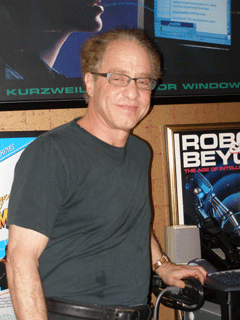
Ray Kurzweil (Photo: Dennis Foley)
CURWOOD: It’s Living on Earth. I’m Steve Curwood.
[MUSIC: Herbie Hancock: “Tell Me A Bedtime Story” from The Essential Herbie Hancock (Legacy records 2007)]
CURWOOD: If you think that computers and machines have taken over your life—just wait! Ray Kurzweil says soon we'll be married—literally.
Ray Kurzweil is one of the foremost inventors of our age and he says the fusion of man and machine is imminent. He calls it ‘the singularity.’
RAMONA: Raymond has invented many things. Like that reading machine for the blind. Oh, and me.
CURWOOD: That's Ramona—an example of AI, artificial intelligence, and the hostess of Ray's website. We joined him in his Kurzweil Technologies office outside of Boston to talk about his theories and predictions and meet some of his brainchildren.
Ray Kurzweil invented the first text-to-speech reader for the blind back in 1976. It was the size of a small washing machine and the sound technology was still in its infancy.
BLIND READER: Scanner moving to top of page. Four score and seven years ago our fathers brought forth upon this continent a new nation conceived in liberty and dedicated to the proposition that all men are created equal...
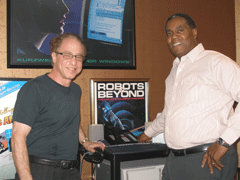
Ray Kurzweil and Steve Curwood (Photo: Dennis Foley)
TRANSLATING TELEPHONE: The rain in Spain, (French translation), stays mainly in the plains (French translation).
[MUSIC: All music was performed on the Kurzweil K250 from various online sources including Keyboard Museum.org/soundsheet/k250, Jane Brockman: Kurzweil Etudes (Janebrockman.com), Steven Johannesson: Minuttish (Rude Boys Music, http://www.middleofnowhere.com/music_archive.asp) ]
CURWOOD: Perhaps the most familiar invention to bear the Kurzweil name is the synthesizer that's capable of recreating virtually all the orchestral instruments. In fact all the music you hear in this story was created using the Kurzweil 250.
[MUSIC: Kurzweil K250]
CURWOOD: But what excites him most is what he sees over the horizon now. What he calls 'the singularity.' And what does he mean by that?
KURZWEIL: Well, it primarily refers to our merging with our technology and greatly expanding our human potential. Literally the word refers to a profound transformation. And here we’re using it in a context of human history, in that there will be a great transformation of human society. I put it around twenty forty-five. Where we will greatly expand our capabilities by merging with our technology. And to be a little more specific, by the late twenty-twenties we’ll have both the hardware and the software to create machines that are at human levels of intelligence. We’ve already modeled and simulated twenty different regions of the brain. And we can test those simulations and they perform equivalently to human performance of those brain regions. And the hardware will be quite capable of actually being much more powerful than the human brain.
CURWOOD: So you’re saying in the next twenty-five years—
KURZWEIL: Right.
CURWOOD: The machines will be as smart as we are?
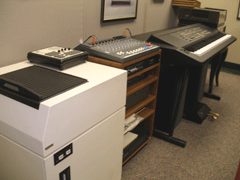
The original text-to-speech reading machine (far left) for the blind and a version of Kurzweil's synthesizer (far right.) (Photo: Dennis Foley)
CURWOOD: For example?
KURZWEIL: Well every time you send an email or connect a cell phone call, intelligent algorithms read the information. Intelligent software flies and lands airplanes, guides intelligent weapons systems, automatically diagnoses electro-cardiogram signals, blood cell images, and I could go on.
If all the intelligent software, and by intelligent software I mean software doing things that used to require human intelligence, were to stop tomorrow, our modern infrastructure would grind to a halt. And that was not true twenty years ago. These projects I just mentioned were research projects twenty years ago.
[MUSIC: Kurzweil K250]
KURZWEIL: The first industrial revolution we extended the reach of our muscles so we can build skyscrapers and so on. And now we’re expanding the reach of our minds and we routinely every day do things that would be impossible without these brain extenders. So we’re routinely expanding our intelligence with our machines today.

The modern, handheld, text-to-speech reading machine for the blind. (Photo: Dennis Foley)
KURZWEIL: We're going to ultimately merge with this technology. And the way we’re going to do that is by getting closer and closer to it. The first computers were very remote. Now they’re in our pockets. They’ll make their way into our clothing. There already are many of these examples of these machines going inside our bodies and brains. If you have Parkinson’s Disease you can have a pea-sized computer put in your brain that actually performs a function of that brain region that was destroyed by the disease. And the latest generation of this FDA-approved neural implant for Parkinson’s Disease, allows you to download new software to your neural implant from outside the patient.
This technology’s not moving along at a slow pace. It’s moving at an exponential pace. And one of my key points is that we’re doubling the power, as measured by price performance and capacity, of information technology every year.
[MUSIC: Kurzweil K250]
CURWOOD: Incredibly fast and incredibly tiny. And soon, says Ray Kurzweil, we'll have robots the size of blood cells—nanobots!
KURZWEIL: So, my vision of what life will be like in the late twenty-twenties, is we will have millions of these nano-bots inside our blood stream. They’ll be keeping us healthy from inside, repairing DNA errors, removing debris, killing cancer cells, augmenting the immune system.

Ray Kurzweil (Photo: Dennis Foley)
They’ll go inside our brains, through the capillaries, non-invasively. Unlike today’s neural implant for Parkinson’s, it won’t require surgery. And it can then actually extend our mental functioning. One thing it can do, for example, is provide full-emersion virtual reality from within the nervous system. So, if we want to go into virtual reality, the nanobots shut down the signals coming from your real sensors, replacing them with the signals that your brain would be receiving if you were in the virtual environment. Then your brain feels like it’s in that environment. You go to move your hand, it moves your virtual hand. Design of new virtual environments will be a new art form. But mostly it’s going to actually extend human intelligence, which arguably computers do today even if most of them are not yet inside our bodies and brains.
CURWOOD: So you must have loved the movie “The Matrix.”
KURZWEIL: Well, “The Matrix” was a cool movie. And that kind of virtual reality will be feasible. You know a lot of these movies paint the future in dystopian terms. And the technology has sort of a sinister feel to it. You know the telephone is virtual reality. You and I can be in the same virtual space even if we’re hundreds of miles away, at least as far as talking is concerned. Well, we’ll add the other senses. The visual sense we can already do in primitive ways. But we’ll actually have full emersion virtual reality involving all the senses. But it’ll be like a telephone, it just won’t be restricted to the auditory sense. It’s not necessarily going to be a kind of sinister thing that we see in the science futurism movies.
[MUSIC: Kurzweil K250]
CURWOOD: What's the one thing that really grabs you as you look ahead?
KURZWEIL: We're going to dramatically change what it means to be human and there are already debates as to what does it mean to be human. In my mind being human means incorporating our technology that we have. It always has. We are the human-machine civilization. We're the only species that creates technology—that’s really what's unique about human beings.
[MUSIC: Kurzweil K250]
CURWOOD: Ray Kurzweil is a futurist and inventor, author of "The Singularity Is Near: When Humans Transcend Biology." This was the first of a two-part conversation we'll have with him. Next time we’ll hear how to hear how he says our new marriage with our technology will radically extend our lives.
KURZWEIL: People say ‘well, if you live hundreds of years, it would get very boring,’ and that's actually true if we didn't also have radical life expansion with the radical life extension. We can expand who we are physically and mostly mentally by putting these nanobots inside our brain and expanding our ability to think and be creative.
Related links:
- Ray Kurzweil's vision for the future
- Ray Kurzweil's companies
Lieutenant Fluffy?
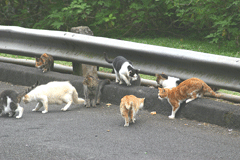
Feral cats in Hawaii. (Photo: Flickr/Sara Golemon)
CURWOOD: Experts reckon there are about seventy million feral cats in the U.S. These are the offspring of domestic pets that got lost or ran away—and they’re blamed for the wholesale slaughter of millions of wild birds. Now a unique program called ‘working cats’ has found a job for feral cats—dealing with other widespread pests—rats and mice.
Voice for the Animals Foundation collects these wild cats, has them spayed or neutered, and then relocates them to places over-run with rodents. The Los Angeles Police Department’s Southeast Division is the newest ‘home’ for a colony of feral cats. LAPD Commander Kirk Albanese helped organize the working cats at several police precincts. So commander, how bad did the problem get?
ALBANESE: It got bad enough that inside the station, we actually had mice that would run across the top of desks and obviously employees didn’t want to see that. And so it was a big enough problem where it was impacting the morale of the work force and we needed to do something about it.
CURWOOD: So you have some cats down there at the police station. How does this work—the cats kill the rats, they have access to an easy meal?
ALBANESE: No. The cats, the scent that they produce, keeps the rodents away. The rodents are afraid of the animals and the cats don’t have to kill the rodents at all. They stay away because of the scent. They don’t want any part of the same neighborhood with the cats and they go on to other places.
CURWOOD: So it’s like one tough gang moves in and the other one moves out.
ALBANESE: Yeah, you could use that analogy. Absolutely.

Feral cats in Hawaii. (Photo: Flickr/Sara Golemon)
ALBANESE: It’s nature. There’s no spraying. There’s no chemicals. There’s no traps. We feed these animals like you would feed any other cat and provide kitty litter and a little housing—a cat crate or whatever they call it. And that’s it.
CURWOOD: How do you condition these cats to work at the police station? And can you use these elsewhere, say in a school or someplace else that also has a rodent problem?
ALBANESE: The way we condition them is they’re kept in a cage—their cat cage—for a couple of weeks. And that allows them or causes them to become territorial. It also allows them to colonize with the other cats that are there next to them. And then when they’re removed from the cages, they stay on the property. And if I had a business with a rodent problem this would definitely be the direction I would go. The exterminators probably don’t want to hear that but I’m convinced it’s a very effective method of dealing with a difficult problem.
CURWOOD: What would be the fate of these feral cats if they didn’t get jobs at the police station?
ALBANESE: Well, if they were at a shelter, eventually they’d be euthanized.
CURWOOD: So, this is really a lifesaving opportunity, then?
ALBANESE: Yeah. I think you could literally say that it’s a lifesaving opportunity and it’s a good deal for us and for the cats.
CURWOOD: So, you’d rate this as fairly successful, then?
ALBANESE: I would rate it as highly successful. In fact, we’re now expanding the program to other stations. We use at (inaudible), at Foothills station, which is one of our older facilities and has a basement where we kept just records—case files and whatnot. And we had a lot of mice down in the basement for whatever reason they congregated down there and at night they would come up, run down the hall, and search for food or whatnot and so that was a problem there. We actually in that case, we put the feral cats in the basement, which solved the problem there.
CURWOOD: Now I’ve got to ask you, commander. I know these are tough guy cats, tough bay cats, they don’t pay any mind to you but maybe you have a favorite, anyway?
ALBANESE: (laughs) You know what, I have to tell you I think they were—because they solved the problem for us—they were all my favorite. You know, I knew what they were doing out there and just by their mere presence so I was very much a proponent and instructed my people, ‘drive out of there with caution, make sure we don’t hit one of these little guys.’ And to date we have not, they stay out of the way of the moving cars. So, they’re all my favorites.
CURWOOD: Kirk Albanese is a commander with the Los Angeles Police Department. Thank you so much.
ALBANESE: My pleasure.
Related link:
Voice for the Animals Foundation
Born to Be Wild

Tatiana at the San Francisco Zoo in October, 2007. (Photo: Flickr/MumbleyJoe)
CURWOOD: Another cat story shocked the nation on Christmas Day. That was the news that Tatiana, a Siberian tiger, escaped her San Francisco Zoo enclosure, killed one young man and mauled two others before police shot and killed her.
Now there’s debate about what went wrong. Commentator Sy Montgomery asks we consider different issues.
MONTGOMERY: How could this have happened? Was the tiger helped out of its enclosure? Did the men provoke the attack? Did they tease the tiger?
In the aftermath of the San Francisco Zoo tragedy, we’re asking the wrong questions. A tiger attacked three people, and we’re at a loss to understand why. That’s because we completely misunderstand predators.
True, if you taunt a tiger, you should prepare for natural selection to do its work. But tigers don’t attack because they’re angry. Tigers don’t attack because they are mean. Tigers attack because they are tigers.

Tatiana at the San Francisco Zoo in October, 2007.
(Photo: Flickr/MumbleyJoe)
Like all predators, tigers love nothing in this world more than to hunt—to stalk, to chase, to spring. A kitten playing with a ball of string is doing the same thing. For a predator, hunting is the most essential and rewarding of all pleasures.
And Tatiana? She probably didn’t mean to hurt anyone. That people were hurt was incidental. What Tatiana wanted—what all tigers want, what all predators want—was not to kill, not to eat—she was well-fed at the zoo—but to hunt. It’s what predators do.
Falconers—folks who hunt with the predatory birds—know all about this. In the elaborate lexicon of falconry, there is a word that addresses this instinctive hunting desire: yarak. At the New Hampshire School of Falconry, my instructor Nancy Cowan said yarak doesn’t have a precise definition. It might come from the Persian word for power or strength—or from the Turkic for the right heat for tempering metal. But falconers know what it means—and what you do about it.
Yarak is the often explosive build-up of hunting drive. The falconer ignores it at his peril. Otherwise, your bird might fly at your face with her talons. Not that she’s hungry or angry. She’s frustrated, deprived of her chance to chase.
Most American zoos won’t let their tigers chase live prey. The public doesn’t want to see that, or even know about it. But—and here’s the odd thing—the public wants to see tigers. We want to admire these ‘magnificent predators.’ As long as the predators are harmless. As long as they don’t kill anything.
But then, are we really seeing a predator? Can we hope to understand a predator that never chases prey? Do we have the right to keep tigers in captivity? Is there a way to keep a captive tiger psychologically whole? Can we honor their yarak?
These are the questions we should be asking—and we should answer them before another Tatiana pays with her life for the sin of being a tiger.
CURWOOD: Author Sy Montgomery works with wild tigers in India. Her book about her experiences is called “Spell of the Tiger: The Man-Eaters of Sundarbans.”
Related links:
- Sy Montgomery's bio
- "The Man-Eating Tigers of Sundarbans" by Sy Montgomery
[MUSIC: Various Artists “Tiger” from Wider Horizons (Liquid Sound Design 2005)]
CURWOOD: On the next Living on Earth—a high-speed wireless network helps environmental scientists gather remote field information—in a way they never could before.
BRYANT: There are two things that are happening. You're getting the data in real time, so you can see if a sensor fails or if your data is good, and you can also have many more sensors in the field.
CURWOOD: Wireless science—next time on Living on Earth.
|
|
[PENGUIN NOISES]
CURWOOD: We leave you this week in the company of penguins. These emperor penguins, made famous by the movie “March of the Penguins,” are the largest of all of these tuxedo-clad birds. They spend their lives on the Antarctic ice and search for food in the ocean waters. Douglas Quin braved the cold and recorded their calls for the CD “Antarctica,” produced by wild sanctuary.com.
[MUSIC: Douglas Quin “Antarctica” from ‘Wild Sanctuary’ (BMI—2002)]
CURWOOD: Living on Earth is produced by the World Media Foundation. Our crew includes Ashley Ahearn, Bobby Bascomb, Eileen Bolinsky, Bruce Gellerman, Ingrid Lobet, Helen Palmer, Emily Taylor, and Jeff Young, with help from Jennifer Baessler and Sarah Calkins. Our interns are Alexandra Gutierrez and Mitra Taj.
Jeff Turton is our technical director. Alison Lirish Dean composed our themes. You can find us anytime at loe.org. I’m Steve Curwood. Thanks for listening.
ANOUNCER: Funding for Living on Earth comes from the National Science Foundation, supporting coverage of emerging science; And Stonyfield Farm Organic yogurt and smoothies. Stonyfield pays its farmers not to use artificial growth hormones on their cows. Details at Stonyfield.com.
Support also comes from you our listeners, the Ford Foundation, The Town Creek Foundation, the Oak Foundation supporting coverage of climate change and marine issues. And Pax World mutual funds, socially and environmentally sustainable investing. Pax World, for tomorrow. On the web at paxworld.com.
ANNOUNCER 2: PRI, Public Radio International.
Living on Earth wants to hear from you!
Living on Earth
62 Calef Highway, Suite 212
Lee, NH 03861
Telephone: 617-287-4121
E-mail: comments@loe.org
Newsletter [Click here]
Donate to Living on Earth!
Living on Earth is an independent media program and relies entirely on contributions from listeners and institutions supporting public service. Please donate now to preserve an independent environmental voice.
NewsletterLiving on Earth offers a weekly delivery of the show's rundown to your mailbox. Sign up for our newsletter today!
 Sailors For The Sea: Be the change you want to sea.
Sailors For The Sea: Be the change you want to sea.
 The Grantham Foundation for the Protection of the Environment: Committed to protecting and improving the health of the global environment.
The Grantham Foundation for the Protection of the Environment: Committed to protecting and improving the health of the global environment.
 Contribute to Living on Earth and receive, as our gift to you, an archival print of one of Mark Seth Lender's extraordinary wildlife photographs. Follow the link to see Mark's current collection of photographs.
Contribute to Living on Earth and receive, as our gift to you, an archival print of one of Mark Seth Lender's extraordinary wildlife photographs. Follow the link to see Mark's current collection of photographs.
 Buy a signed copy of Mark Seth Lender's book Smeagull the Seagull & support Living on Earth
Buy a signed copy of Mark Seth Lender's book Smeagull the Seagull & support Living on Earth


